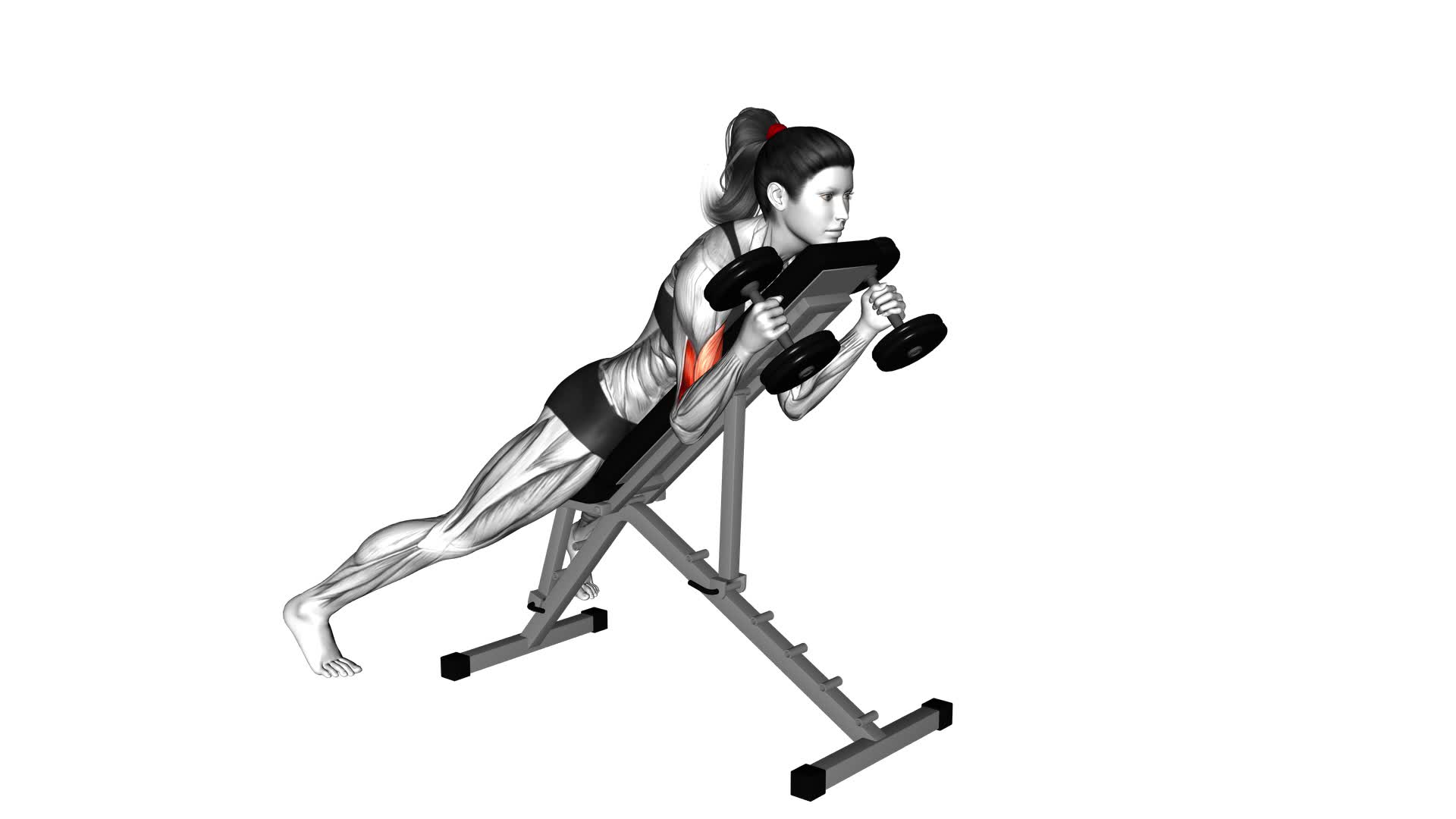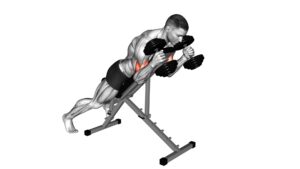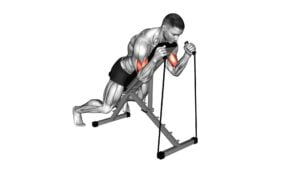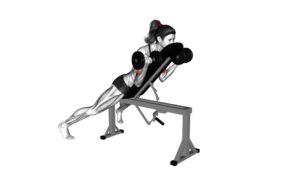Dumbbell Prone Incline Hammer Curl (female) – Video Exercise Guide & Tips

Looking to sculpt your arms and build strength? The Dumbbell Prone Incline Hammer Curl is the exercise for you. In this video exercise guide, we'll show you the proper form and technique to maximize your results.
Watch This Exercise Video
With variations to challenge and progress your workout, you'll be on your way to toned and defined arms in no time. Follow our tips to avoid common mistakes and get the most out of this effective exercise.
Let's get started!
Key Takeaways
- Targets the biceps brachii, brachialis, and brachioradialis muscles
- Increases muscle definition and strength in the arms
- Engages the muscles from a different angle compared to traditional bicep curls
- Improves grip strength over time
Benefits of the Dumbbell Prone Incline Hammer Curl
The dumbbell prone incline hammer curl offers a variety of benefits for women who want to build strength and tone their arms. This exercise primarily targets the biceps brachii, which is the muscle responsible for flexing the elbow joint. By performing this exercise, you can expect to see an increase in muscle definition and strength in your arms. Additionally, the dumbbell prone incline hammer curl also engages the brachialis and brachioradialis muscles, further enhancing the overall development of your arm muscles.
One of the key benefits of this exercise is that it allows you to work your biceps from a different angle compared to traditional bicep curls. The prone incline position puts your arms in a slightly stretched position, which increases the tension on the biceps muscles and leads to greater muscle activation. This can result in more efficient muscle growth and improved overall arm strength.
Incorporating the dumbbell prone incline hammer curl into your workout routine can also help improve your grip strength. As you hold onto the dumbbells and perform the curling motion, your forearms and hand muscles are actively engaged, leading to increased grip strength over time.
Proper form and technique for the exercise is crucial to maximize the benefits and minimize the risk of injury. Let's now dive into the details of how to perform the dumbbell prone incline hammer curl correctly.
Proper Form and Technique for the Exercise
To perform the dumbbell prone incline hammer curl correctly, you need to maintain proper form and technique. This will ensure that you target the right muscles and avoid any potential injuries. One common mistake to avoid is using excessive weight, as this can compromise your form and put unnecessary strain on your muscles. Start with a weight that allows you to complete the exercise with proper technique and gradually increase the weight as you become stronger.
When performing the dumbbell prone incline hammer curl, make sure to keep your back flat against the bench and your feet firmly planted on the ground. Keep your elbows close to your sides and avoid swinging the weights up using momentum. Instead, focus on contracting your biceps and lifting the weights in a controlled manner.
Another mistake to avoid is lifting your shoulders or shrugging them up during the exercise. Keep your shoulders relaxed and down throughout the movement to maintain proper form.
Incorporating the dumbbell prone incline hammer curl into your workout routine can help strengthen and sculpt your biceps, forearms, and shoulders. Remember to start with lighter weights and gradually increase the weight as you progress. This will help you challenge your muscles and continue to make progress in your fitness journey.
Now, let's explore some variations to challenge and progress your workout.
Variations to Challenge and Progress Your Workout
To challenge and progress your workout, consider incorporating different variations and modifications of the dumbbell prone incline hammer curl.
By adding variety to your routine, you can target different muscle groups and continue to make gains in strength and definition.
One variation you can try is the single-arm dumbbell prone incline hammer curl. Instead of using both arms simultaneously, this variation allows you to focus on each arm individually, maximizing the contraction and engagement of the biceps.
Another modification is the incline alternating dumbbell hammer curl. This involves alternating the curling motion between your right and left arms while maintaining the incline position. This variation not only challenges your biceps but also improves your coordination and stability.
For those looking for an advanced modification, the incline eccentric dumbbell hammer curl is a great choice. With this variation, you focus on the eccentric or lowering phase of the exercise. Slowly lower the dumbbells back down to the starting position, emphasizing the negative movement. This places additional stress on the muscles, leading to greater gains in strength and muscle development.
Incorporating these variations and modifications into your workout routine won't only keep your workouts interesting but also challenge your muscles in new ways. Remember to start with a weight that allows you to maintain proper form and gradually increase the resistance as you become more comfortable and confident with each variation.
Tips for Maximizing Results and Avoiding Common Mistakes
To maximize your results and avoid common mistakes, it's important to pay attention to your form and technique during the dumbbell prone incline hammer curl. This exercise can be highly effective in targeting your biceps and forearms, but only if performed correctly. Here are some tips for success:
- Maintain proper posture: Keep your back flat against the bench and your core engaged throughout the exercise. This will help prevent any unnecessary strain on your lower back.
- Start with lighter weights: It's better to start with lighter dumbbells and gradually increase the weight as you become more comfortable with the exercise. This will ensure that you maintain proper form and avoid any risk of injury.
- Control the movement: Focus on the controlled movement of lifting and lowering the weights. Avoid using momentum or swinging your arms, as this takes away from the effectiveness of the exercise.
- Keep your elbows stationary: The movement should come from your forearms, not your upper arms. Keep your elbows locked in place throughout the exercise to isolate your biceps and forearms.
- Breathe properly: Remember to exhale as you curl the weights up and inhale as you lower them back down. Proper breathing technique helps with stability and overall performance.
Sample Workout Routine Incorporating the Dumbbell Prone Incline Hammer Curl
Maximize your results and avoid common mistakes by incorporating the dumbbell prone incline hammer curl into a sample workout routine. This exercise is perfect for muscle toning and can be easily incorporated into your upper body workout.
To begin, start by setting an incline bench at a 45-degree angle. Grab a pair of dumbbells and lie face down on the bench with your chest resting against it. Let your arms hang straight down, palms facing each other. This is your starting position.
Next, exhale and slowly curl the dumbbells towards your shoulders, keeping your elbows close to your body. Squeeze your biceps at the top of the movement for maximum muscle activation. Inhale and slowly lower the dumbbells back to the starting position.
To incorporate the dumbbell prone incline hammer curl into your upper body workout, perform 3 sets of 10-12 repetitions. Rest for 30-60 seconds between sets. You can include this exercise as a superset with other upper body exercises such as push-ups or shoulder presses to maximize your workout efficiency.
Remember to choose a weight that challenges you but still allows you to maintain proper form throughout the exercise. Focus on controlled movements and avoid using momentum to lift the dumbbells.
Frequently Asked Questions
How Many Sets and Reps Should I Do for the Dumbbell Prone Incline Hammer Curl?
For the dumbbell prone incline hammer curl, the number of sets and reps will depend on your fitness goals and current fitness level.
It's important to start with a weight that challenges you but still allows you to maintain proper form.
Generally, 3-4 sets of 8-12 reps is a good starting point.
Remember to rest for about 60-90 seconds between sets.
Always listen to your body and adjust the sets and reps as needed.
Can I Use a Barbell Instead of Dumbbells for This Exercise?
Yes, you can use a barbell instead of dumbbells for the exercise. However, using dumbbells for the dumbbell prone incline hammer curl offers some benefits.
Dumbbells allow for a greater range of motion and engage stabilizer muscles more effectively. They also allow for unilateral training, which helps to correct muscle imbalances.
Additionally, dumbbells provide a more natural movement pattern and require greater core engagement.
Is It Necessary to Have an Incline Bench for the Dumbbell Prone Incline Hammer Curl?
To answer your question, an incline bench isn't necessary for the dumbbell prone incline hammer curl. However, it can provide additional benefits by targeting your muscles at a different angle.
If you don't have access to an incline bench, don't worry! There are alternative exercises you can try to still work your biceps effectively. Some options include standing hammer curls or seated dumbbell curls.
Experiment and find what works best for you!
Can I Do This Exercise if I Have Shoulder or Wrist Pain?
If you're experiencing shoulder or wrist pain, it's important to modify your exercise routine. The dumbbell prone incline hammer curl may not be suitable for you in this case.
However, there are alternative exercises that can target the same muscles without causing discomfort. Speak to a fitness professional or physical therapist for guidance on modifications and alternative exercises that can help you work around your shoulder and wrist pain.
How Often Should I Incorporate the Dumbbell Prone Incline Hammer Curl Into My Workout Routine?
To maximize the benefits of the dumbbell prone incline hammer curl, it's important to consider workout frequency. Incorporating this exercise into your routine two to three times a week can be effective.
This allows for adequate rest and recovery between sessions while still targeting the muscles in your arms and shoulders.
Conclusion
The dumbbell prone incline hammer curl is a great exercise for women looking to strengthen their biceps and forearms. By following proper form and technique, you can maximize results and avoid common mistakes.
Additionally, incorporating variations of this exercise into your workout routine can help challenge and progress your fitness goals.
Remember to always consult with a professional trainer for personalized guidance and to ensure safety.

Author
Years ago, the spark of my life’s passion ignited in my mind the moment I stepped into the local gym for the first time. The inaugural bead of perspiration, the initial endeavor, the very first surge of endorphins, and a sense of pride that washed over me post-workout marked the beginning of my deep-seated interest in strength sports, fitness, and sports nutrition. This very curiosity blossomed rapidly into a profound fascination, propelling me to earn a Master’s degree in Physical Education from the Academy of Physical Education in Krakow, followed by a Sports Manager diploma from the Jagiellonian University. My journey of growth led me to gain more specialized qualifications, such as being a certified personal trainer with a focus on sports dietetics, a lifeguard, and an instructor for wellness and corrective gymnastics. Theoretical knowledge paired seamlessly with practical experience, reinforcing my belief that the transformation of individuals under my guidance was also a reflection of my personal growth. This belief holds true even today. Each day, I strive to push the boundaries and explore new realms. These realms gently elevate me to greater heights. The unique combination of passion for my field and the continuous quest for growth fuels my drive to break new ground.







